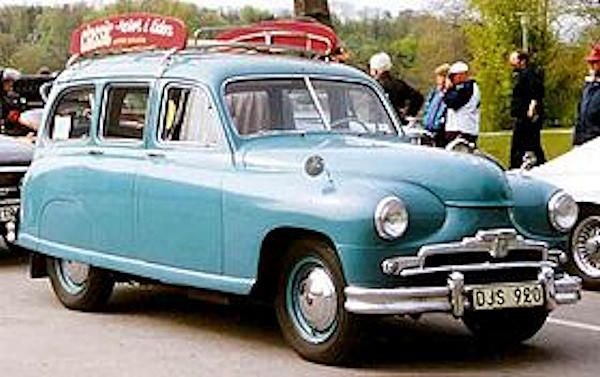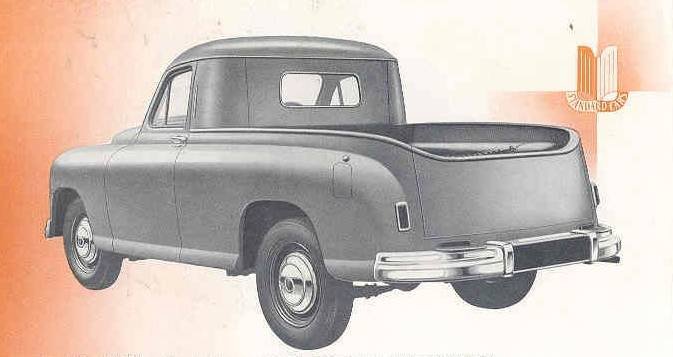Standard Vanguard History Range
 |
|
| Manufacturer | Standard Motor Company |
|---|---|
| Production | 1947–1963 |
| Assembly | United Kingdom Australia New Zealand (Motor Assemblies) |
| Predecessor | none |
| Successor | Triumph 2000 |
The Standard Vanguard is a car produced by the Standard Motor Company in Coventry from 1947 to 1963.
- Vanguard Phase I (1947-1953)
- Vanguard Phase II (1953-1956)
- Vanguard Phase III, Sportsman and Ensign (1955-1958)
- Vanguard Vignale (1958-1961)
- Vanguard Six (1960-1963)
The car was announced in July 1947. It was completely new with no resemblance to the previous models, and was Standard's first post-Second World War car. It was also the first model to carry the new Standard badge, which was a heavily stylised representation of the wings of a Griffin.
In the wake of the Second World War many potential customers in the UK and in English-speaking export markets had recently experienced several years of military or naval service, therefore a car name related to the British Navy carried a greater resonance than it would for later generations. The name of the Standard Vanguard recalled HMS Vanguard, the last of the British Navy's battleships, launched in 1944 amid much media attention: permission to use the name involved Standard in extensive negotiations with senior Royal Navy personnel.
The styling of the car resembled the pre-war Plymouth with a sloping "beetle-back". Russian media claimed that styling of this car had been in part influenced by Russian GAZ-M20 Pobeda, which had been in development from 1943 and went into production in 1946. In 1952 The Motor magazine stated that the Soviet Pobeda "shows a certain exterior resemblance to the Standard Vanguard", disregarding the fact that the Pobeda had been launched a year before the Vanguard.In Scandinavia, Standard marketed the Standard Ten saloon as the "Vanguard Junior".
PERFORMANCE:Standard Vanguard Six Saloon
- max power (SAE): 85 hp at 4500 rpm
- max torque (DIN): 16 kgm at 2500 rpm
- max number of engine rpm: 5000 rpm
- Engine Capacity 122.20 cu in, 1998 cu cm
- Fuel Consumption 25.7 m imp gal, 21.4 m US gal, 11 1 x 100 km;
- Max Speed 90 mph, 144.g km, h
- power-weight ratio: 30 lb/hP, 13.6 kg/hp
- useful load: 1058 1b, 480 kg
- acceleration: 0—50 mph (0— 80 km/h) 13.5 sec
- speed in direct drive at 1000 rpm: 18.0 mph, 29 km/h.
Both the Ensign and the Vanguard were replaced in 1963 by the Triumph 2000 and the Standard name disappeared from the British market after 60 years.
Vanguard Utility

1949 Standard Pickup UTE
Called a pickup truck in the UK, this version had modest sales there, but the main purchaser was the RAF, who had them in Phase I and II form.
In 1950, the Australian subsidiary of the Standard Motor Company introduced a Coupé utility version of the Vanguard Phase I. It was fitted with the same 2088 cc four cylinder engine as used in the saloon. Utility versions of the Vanguard were produced in Australia over the following years with production ending in 1964.
Technical
-
Standard Vanguard Range Technical details and specifications (1947-1963)
ENGINE: Standard Vanguard Six Saloon
front, 4 stroke
cylinders: 6, in line, vertical
bore and stroke: 2.94 x 2.99 in, 74.7 x 76 mm
engine capacity: 122.20 cu in, 1998 cu cm
compression ratio: 8 : 1
cylinder block: cast iron
cylinder head: cast iron
crankshaft bearings: 4
valves; 2 per cylinder, overhead, parallel, with push rods and rockers
camshaft: 1, side
lubrication: gear rotor pump, full flow filter
lubricating system capacity: 3.5 imp qt, 4.2 US qt, 4.0 1
carburation: 2 Solex semi-downdraft carburettors
Fuel feed: mechanical pump
cooling system waterTRANSMISSION:
driving wheels: rear
clutch: single dry plate: gear box: mechanical
gears: 4 + reverse; synchromesh gears: 2nd, 3rd, 4th
gear box ratios: (1st) 3.54, (2nd) 2.10, (3rd) 1.38, (4th) 1, (Rev) 4.55
Option Laycock-de Normanville in 3rd and 4th (ratio 0.82), axle ratio 4.55 : 1
Option Borg-Warner automatic gear box, hydraulic torque convertor and planetary gears with 3 ratios
final drive:hypoid bevel; ratio: 4.10 : 1.CHASSIS:
type integral
front suspension: independent, wishbones, anti-roll bar, coil springs, telescopic dampers
rear suspension: rigid axle, semi-elliptic leaf-springs, telescopic dampers.STEERING:
recirculating ball
turns of steering wheel lock to lock: 4.33.
turning radius (between walls): 19.5 ft, 5.9 mBRAKES:
drum, 2 front leading shoes option front disc brakes
braking surface: total 175.00 sq in, 1128.75 sq cm.ELECTRICAL EQUIPMENT:
voltage: 12 V
battery: 57 Ah
dynamo: 264 W
ignition distributor: Lucas
DIMENSIONS AND WEIGHT: Six Saloon
wheel base: 101.97 in, 2590 mm
front track: 51.57 in, 1310 mm
rear track: 51.57 in, 1310 mm
overall length: 171.46 in, 4355 mm
clearance: 7.28 in, 185 mm
dry weight: 2547 1b, 1155 kg
distribution of weight: 56.5 0/0 front axle, 43.5 rear axle© Motor car History
Service
-
Standard Vanguard Range maintenance and Service Guide (1947-1963)
fuel: petrol, 90 Oct
engine sump oil: 3.5 imp At, 4.2 US qt, 4.0 1, SAE 20, change every 3000 miles, 4800 km
gearbox oil: 0.7 imp qt, 0.8 US qt, 0.8 1, SAE 90, change every 12000 miles, 19300 km
final drive oil: 0.7 imp qt, 0.8 US qt, 0.8 1, SAE 90, change every 6000 miles, 9600 km
greasing: every 1000-6000 miles, 1600-9600 km
tappet clearances: inlet 0.010 inv 0.25 mm, exhaust 0.010 in, 0.25 mm
valve timing: (inlet) opens 180 before tdc and closes 580 after bdc, (exhaust) opens 580 before bdc and closes 180 after tdc
tyre pressure (medium load): front 26 psi, 1.8 atm, rear 24 psi-1.7 atm
tyres: 5.90 or 6.40 - 15
fuel tank capacity: 12.00 imp gal, 14.26 US gal, 54 1.
cooling system capacity: 7 imp qt, 8.5 US qt,© Motor car History
